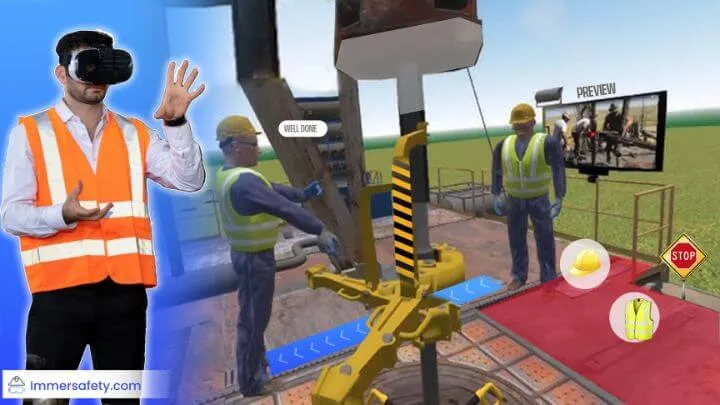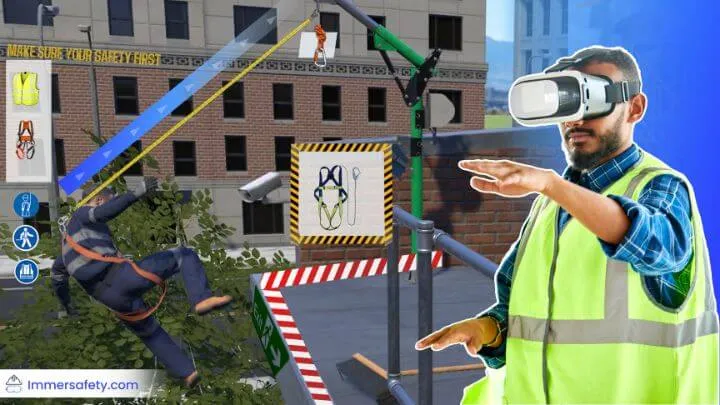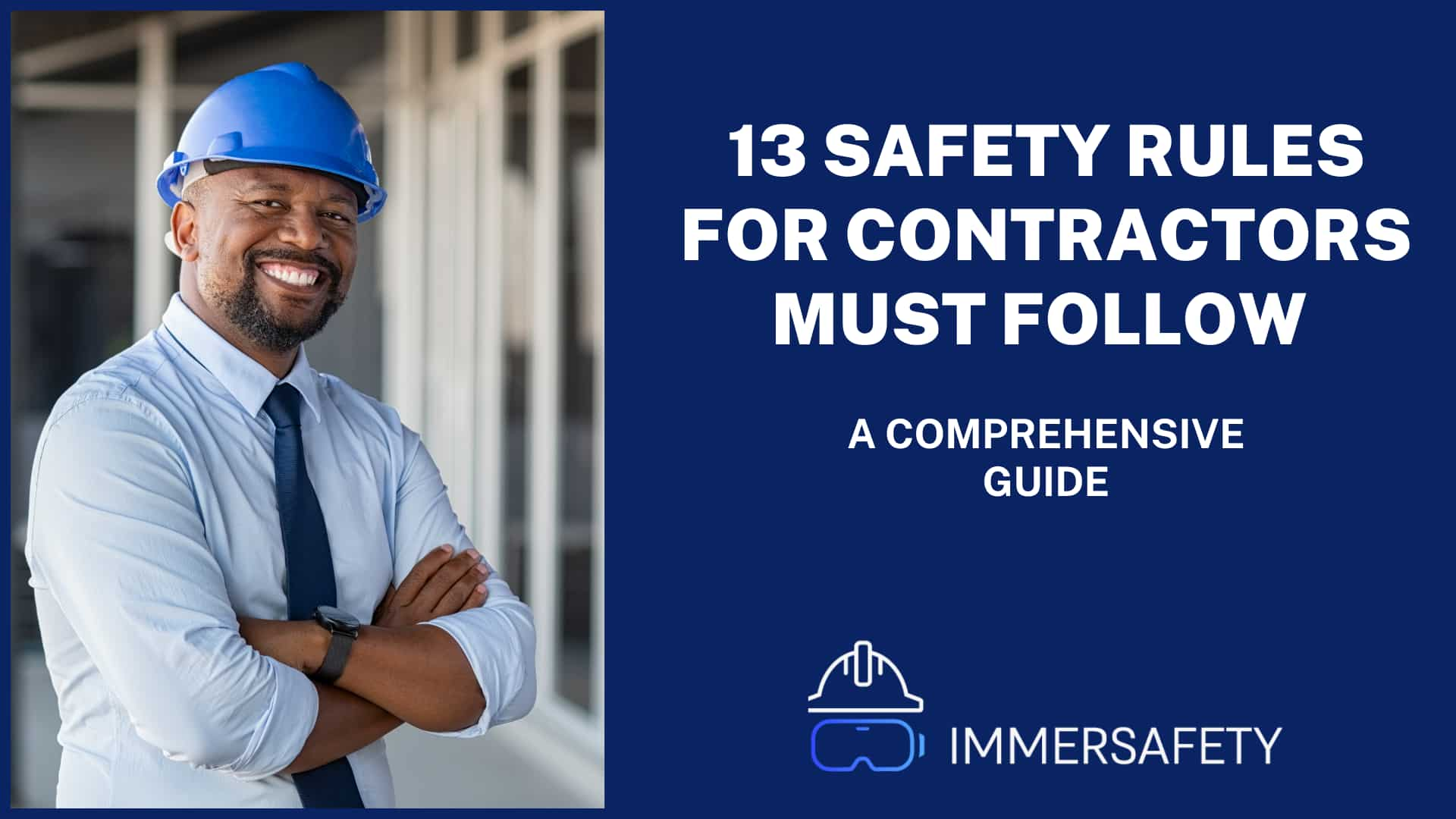Contractors play a pivotal role in the construction industry, overseeing various projects that shape our built environment. However, the nature of construction work also presents significant safety challenges.
Prioritizing safety is not only a legal obligation but a moral responsibility to protect the well-being of workers and ensure the successful completion of projects.
In this blog post, we will delve into 13 crucial safety rules that every contractor must follow to create a safer and more secure working environment for all stakeholders involved.
13 Safety Rules For Contractors In the Construction Industry

1. Lead by Example:
Safety’s foundation rests in leadership. Contractors bear the responsibility of setting the safety precedent. Exhibiting consistent adherence to safety protocols not only fosters a culture of vigilance but establishes a tone that permeates the entire team. A commitment to safety isn’t just spoken; it’s visibly demonstrated, inspiring all to prioritize well-being.
2. Develop a Comprehensive Safety Plan:
Construction safety is strategic. Crafting a meticulous safety plan pre-work initiation is imperative. This document pinpoints potential hazards, drafts preventive strategies, and solidifies emergency responses. Communicating this blueprint to all team members and updating it ensures that evolving risks are consistently addressed.
3. Provide Proper Training:
Knowledge is a safety cornerstone. Equipping every worker with extensive training covering equipment operation, hazard identification, emergency procedures, and adept personal protective equipment (PPE) usage is non-negotiable. This competency enhances decision-making and empowers the workforce.
4. Enforce the Use of PPE:
Protection is indivisible from Personal Protective Equipment (PPE). Contractors enforce PPE wear—hard hats, safety goggles, gloves, and steel-toed boots—as a steadfast barrier against potential construction site perils. This mandate underscores a shared commitment to safeguarding against hazards.
5. Regularly Inspect Equipment and Tools:
Machinery’s reliability hinges on vigilance. Regular equipment and tool inspections are vital. Swiftly addressing defects or malfunctions ensures accidents are averted. Consistent maintenance guarantees access to secure, efficient operational tools, fostering a secure and productive environment.
6. Implement Fall Prevention Measures:
Falls are a leading cause of construction site injuries. Install guardrails, safety nets, and personal fall arrest systems when working at heights. Prioritize fall prevention through comprehensive training and stringent adherence to safety measures.
7. Manage Hazardous Materials Properly:
If your project involves hazardous materials, handle them with care. Provide proper storage, labelling, and disposal methods to prevent environmental contamination and protect worker health.
8. Maintain a Clean and Organized Site:
A cluttered and disorganized construction site increases the risk of accidents. Maintain a clean work environment, promptly removing debris and obstacles, to create a safer and more efficient workspace.
9. Ensure Adequate Ventilation and Air Quality:
In enclosed spaces, poor ventilation can lead to respiratory issues and other health problems. Implement proper ventilation systems and monitor air quality to provide a comfortable and safe work environment.
10. Establish Effective Communication:
Clear communication is vital for preventing accidents. Set up communication channels, such as signals, signs, and two-way radios, to facilitate effective interaction among workers, machinery operators, and other stakeholders.
11. Monitor Weather Conditions:
Outdoor construction projects are susceptible to weather-related risks. Stay informed about weather forecasts and take appropriate precautions to ensure worker safety during adverse conditions such as storms, extreme heat, or cold.
12. Promote Ergonomic Practices:
Encourage proper lifting techniques and ergonomic work practices to reduce the risk of musculoskeletal injuries. Provide ergonomic tools and equipment to support workers in maintaining a healthy posture.
13. Conduct Regular Safety Meetings and Reviews:
Hold frequent safety meetings to discuss ongoing projects, address concerns, and reinforce safety protocols. Use these meetings to share lessons learned from near-miss incidents and continuously improve safety practices.
Use Virtual Reality Training to explain Safety Rules For Contractors
This immersive experience transports contractors into a virtual construction site, replicating real-world scenarios to impart vital safety rules.

Through this training, contractors can:
- Practice Real-time Hazards: Encounter and navigate various construction hazards within a risk-free virtual environment.
- Interactive Learning: Engage in hands-on activities, from wearing virtual PPE to using tools safely, fostering practical skills.
- Emergency Response Simulation: Experience and learn to handle emergencies like fires, collapses, and evacuations.
- Dynamic Feedback: Receive instant feedback on safety decisions, enhancing understanding and improving safety-conscious thinking.
- Adaptive Learning: Tailor the training to individual needs, addressing specific areas of improvement.
This innovative training bridges the gap between theory and practice, equipping contractors with the expertise to lead by example, adhere to comprehensive safety plans, ensure proper equipment use, and maintain a secure work environment. “Enhancing Contractor Safety: Virtual Reality Training” is the future of safety education, elevating industry standards while protecting and empowering the workforce.
Book A FREE VR Safety Training Demo Now
FAQ’s
1. Why are safety rules important for contractors?
Safety rules for contractors are crucial to prevent accidents, injuries, and fatalities on construction sites. They establish a framework to mitigate hazards, protect workers, and ensure a secure work environment.
2. What are some common safety rules that contractors should follow?
Common safety rules for contractors include wearing proper personal protective equipment (PPE), conducting regular equipment inspections, adhering to safe work practices, maintaining clear communication, and following emergency procedures.
3. How can contractors effectively enforce safety rules among their workforce?
Contractors can enforce safety rules by leading by example, providing comprehensive training, conducting regular safety meetings, implementing consequences for rule violations, and creating a culture of accountability and awareness.
4. What should contractors do to address changing safety requirements and regulations?
Contractors should stay informed about updated safety regulations, regularly review and update their safety plans, provide ongoing training to workers, and collaborate with safety professionals to ensure compliance with evolving standards.
5. How can contractors balance productivity with safety when executing construction projects?
Contractors can balance productivity and safety by integrating safety considerations into project planning, involving workers in hazard assessments, optimizing work processes to reduce risks, and fostering a culture where safety is seen as a priority that enhances overall project success.
Final Thoughts For Safety Rule For Contractors
As a contractor, your commitment to safety directly impacts the well-being of your team and the success of your projects.
By adhering to these 13 crucial safety rules, you can create a construction environment that prioritizes the health and safety of all stakeholders.
Remember, safety is not just a set of guidelines – it’s a mindset that should be woven into the fabric of every construction project, ensuring that each worker returns home safely at the end of the day and contributes to the overall success of your endeavours.
Upgrade your safety training to a new level of realism and effectiveness. Contact us now for Virtual Reality For Safety Training that makes a difference.


